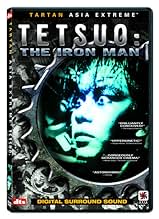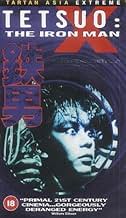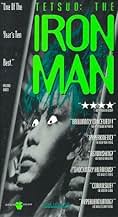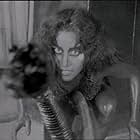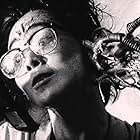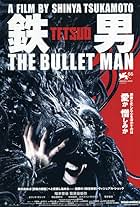VALUTAZIONE IMDb
6,9/10
27.651
LA TUA VALUTAZIONE
Un uomo d'affari uccide accidentalmente The Metal Fetishist, che ottiene la sua vendetta trasformando lentamente l'uomo in un grottesco ibrido di carne e metallo.Un uomo d'affari uccide accidentalmente The Metal Fetishist, che ottiene la sua vendetta trasformando lentamente l'uomo in un grottesco ibrido di carne e metallo.Un uomo d'affari uccide accidentalmente The Metal Fetishist, che ottiene la sua vendetta trasformando lentamente l'uomo in un grottesco ibrido di carne e metallo.
- Premi
- 2 vittorie totali
Recensioni in evidenza
Japan is a crazy country. Their workaholism is affecting western culture all the time. Coming to Tokyo first time, one can get lost not only in translation, hehe, but mostly in all these technological gadgets that leave you with only three questions: "what the hell is this for?", "what the hell is that for?", and "how the hell does it work?". On one side, coming to Japan, one might see something very rare today: amazing technology next to tradition, remains of culture hundreds and thousands years old. But on the other, Japanese does seem to have a lot of fear about all that technology. Won't that materialistic, technological approach kill emotional and spiritual aspects of human existence? There has been made a lot of movies asking that question, projecting hypothetical versions of future based on what Japan looks like today. See Ghost in the Shell for example. Yeah, alright, but what does Tetsuo have to do with all that crap? Everything. This Tsukamoto piece of art is a manifestation of great great fear of cold and soulless technology. Main character is a guy who has rather serious problem: one day he notices that metal parts are slowly beginning to reveal themselves from under his skin. Why, and what does it mean? Where will it lead to? You'll see. What I can say is that you don't need to live in Japan to enjoy this movie. The atmosphere is amazingly unconventional, and can be compared only to other industrial/anti-industrial masterpieces of Japanese cinema. The movie is black and white only all the time. Camera work is incredible, it builds intense paranoid atmosphere. If you've seen other Shinya's movies, you know what you can expect. The way the story is told, with all these cut-and-paste elements... oh God :D If you've already seen some totally psyched-out movies like this one, you might get a laugh sometimes, otherwise I guarantee you'll be strongly shocked, because as I said before: you probably haven't seen anything like this before, so watch your back, you have been warned ;) Budget used to make this movie may be equal to something like two cokes and a hamburger, but, as we can see, some don't waste even that small amount of money. There are movies made with a little help of millions of dollars which are not even worth a cent. On the other side, there are gems like this, where you can't notice signs of low-budget, because it doesn't harm this movie even in one moment. I can't think of one thing I'd change in this movie. Highly recommended, this one is a blast!
PS. If you're willing to get some other Tsukamoto movies, avoid Hiruko the Goblin.
PS. If you're willing to get some other Tsukamoto movies, avoid Hiruko the Goblin.
Shinya Tsukamoto's Tetsuo has been one of my favourite ultra underground Japanese films for some time now. I've watched it many times, and the film is always as effective, stunning and outstanding as it was when I first saw it. Now I viewed it again last night, and I am totally shocked and speechless, when it comes to this masterpiece of Shinya Tsukamoto, the genius multi talent behind films like Tokyo Fist (just don't try to watch if you think Raging Bull is too much), Gemini and Bullet Ballet. If I had to choose one film among all the films that really blew me away like this, I'd probably choose Tetsuo.
The "plot" and premise is simple. A metal fetishist (played by the director himself) inserts pieces of metal into his own body with often bloody results, understandably. He becomes run down by a car after which the fetishist starts to have very severe changes in his body and starts to mutate into human/metal monster and the man who ran him down starts to have similar changes in his body, too.. What follows is 60 minutes of total surreal mayhem, nightmarish imagery and use of perhaps all the imaginable cinematic techniques in editing, photography and music. You have been warned!
It is hard to describe with words the power of this film, which has often been referred as a combination of Lynch, Cronenberg and of course Anime and Sci-fi. The photography is stunning to say the least as director's 16mm camera twists, turns, runs, falls, climbs, zooms and does all the possible ways the director could invent to create this kind of atmosphere. The film consists of (very) fast edits, flashbacks, nightmare sequences and images and fast forward photography that spiced with incredible soundtrack is something never before seen. The soundtrack is made with different sounds of metal hitting together, scratching against something and most notable, there is also synthesizer use to create very ominous and threatening atmosphere that never stops, and the music is again one of the most important elements of this film.
The effects are totally outstanding as the director made them by himself. The film is black and white and that is of course great choice to nightmare film like this. Tsukamoto also wrote, directed, photographed, art directed and edited this film among special effects, and the most help he got came probably from Kei Fujiwara, who plays the girl friend in the movie, and she also directed her own similar film, Organ, in the middle of the 90's. It is incredible how Tsukamoto managed to do all this by himself and the help of some others, but due to his talent, it all becomes possible. This film is very low budget, but it is the kind of punch to senses that only very few big budget films have managed to give. If I had to choose one "big budgeted" film that has almost equally stunning atmosphere and power, I'd mention Darren Aronofsky's Requiem for a Dream, which is another masterpiece from this young director/writer. Still Requiem and Tetsuo are very different films, but their power is almost - if not entirely - equal.
The theme of the film is obviously the fear of technology and how far it will be developed. The film ends pretty pessimistically and it underlines the fears and threats that are in the air and were in Tsukamoto's mind, too. The images of huge metal machines and motors at the beginning of the movie, are very ominous and the machines seem to be alive and are very nightmarish overall, even though they should be DEAD machines because metal doesn't live, at least yet. This reminded me of work of David Lynch and his Eraserhead and Lost Highway, which both create something very ominous, dangerous and very scary with these similar techniques of close ups of water spilling, engines working and smoke coming closer. Just remember the images of radiator and coffee-pot in Eraserhead and mystery man and smoke (among many others) in Lost Highway. The feeling in Tetsuo is exactly similar, even though the things themselves are not scary or threatening, because they should be only dead pieces of metal and plastic, products in other words.
Shinya Tsukamoto made also sequel to Tetsuo, but it is in color and never as stunning as this brilliant original, but still worth checking out for lovers of this kind of cinema. Shinya Tsukamoto is among Takeshi Kitano, Takashi Ishii and Takashi Miike the most interesting, personal, creatively lunatic and overall stunning artists to come from Japan today, and by watching their films, all the nonsense entertainment coming too often from Hollywood nowadays is easy to forget and just concentrate on these miracles in the field of cinema. Cinema is magic and Tetsuo is one example to show that for the lovers of independent films, since this is not going to reveal to mainstream audience due to its difficult imagery, violent scenes of nightmarish terror and overall personality that demands a lot from the viewer. This is far too difficult and intelligent cinema for mainstream audience, and thus would never come out from some big studio that wants only money and commercially potential films.
Tetsuo is a 10/10 masterpiece and one of my personal favourites. I've tried to describe this film as clearly as possible, and without using too many praising adjectives, and since this movie's power is somewhat hard to describe with words, I recommend that all the lovers of Japanese cinema and the ones who think they're interested in Tetsuo check this out and see and experience the magic for themselves.
The "plot" and premise is simple. A metal fetishist (played by the director himself) inserts pieces of metal into his own body with often bloody results, understandably. He becomes run down by a car after which the fetishist starts to have very severe changes in his body and starts to mutate into human/metal monster and the man who ran him down starts to have similar changes in his body, too.. What follows is 60 minutes of total surreal mayhem, nightmarish imagery and use of perhaps all the imaginable cinematic techniques in editing, photography and music. You have been warned!
It is hard to describe with words the power of this film, which has often been referred as a combination of Lynch, Cronenberg and of course Anime and Sci-fi. The photography is stunning to say the least as director's 16mm camera twists, turns, runs, falls, climbs, zooms and does all the possible ways the director could invent to create this kind of atmosphere. The film consists of (very) fast edits, flashbacks, nightmare sequences and images and fast forward photography that spiced with incredible soundtrack is something never before seen. The soundtrack is made with different sounds of metal hitting together, scratching against something and most notable, there is also synthesizer use to create very ominous and threatening atmosphere that never stops, and the music is again one of the most important elements of this film.
The effects are totally outstanding as the director made them by himself. The film is black and white and that is of course great choice to nightmare film like this. Tsukamoto also wrote, directed, photographed, art directed and edited this film among special effects, and the most help he got came probably from Kei Fujiwara, who plays the girl friend in the movie, and she also directed her own similar film, Organ, in the middle of the 90's. It is incredible how Tsukamoto managed to do all this by himself and the help of some others, but due to his talent, it all becomes possible. This film is very low budget, but it is the kind of punch to senses that only very few big budget films have managed to give. If I had to choose one "big budgeted" film that has almost equally stunning atmosphere and power, I'd mention Darren Aronofsky's Requiem for a Dream, which is another masterpiece from this young director/writer. Still Requiem and Tetsuo are very different films, but their power is almost - if not entirely - equal.
The theme of the film is obviously the fear of technology and how far it will be developed. The film ends pretty pessimistically and it underlines the fears and threats that are in the air and were in Tsukamoto's mind, too. The images of huge metal machines and motors at the beginning of the movie, are very ominous and the machines seem to be alive and are very nightmarish overall, even though they should be DEAD machines because metal doesn't live, at least yet. This reminded me of work of David Lynch and his Eraserhead and Lost Highway, which both create something very ominous, dangerous and very scary with these similar techniques of close ups of water spilling, engines working and smoke coming closer. Just remember the images of radiator and coffee-pot in Eraserhead and mystery man and smoke (among many others) in Lost Highway. The feeling in Tetsuo is exactly similar, even though the things themselves are not scary or threatening, because they should be only dead pieces of metal and plastic, products in other words.
Shinya Tsukamoto made also sequel to Tetsuo, but it is in color and never as stunning as this brilliant original, but still worth checking out for lovers of this kind of cinema. Shinya Tsukamoto is among Takeshi Kitano, Takashi Ishii and Takashi Miike the most interesting, personal, creatively lunatic and overall stunning artists to come from Japan today, and by watching their films, all the nonsense entertainment coming too often from Hollywood nowadays is easy to forget and just concentrate on these miracles in the field of cinema. Cinema is magic and Tetsuo is one example to show that for the lovers of independent films, since this is not going to reveal to mainstream audience due to its difficult imagery, violent scenes of nightmarish terror and overall personality that demands a lot from the viewer. This is far too difficult and intelligent cinema for mainstream audience, and thus would never come out from some big studio that wants only money and commercially potential films.
Tetsuo is a 10/10 masterpiece and one of my personal favourites. I've tried to describe this film as clearly as possible, and without using too many praising adjectives, and since this movie's power is somewhat hard to describe with words, I recommend that all the lovers of Japanese cinema and the ones who think they're interested in Tetsuo check this out and see and experience the magic for themselves.
I heard about this movie reading a comic book magazine in elementary school. It piqued my interest and I searched for it on video for rental for several months before finding it. Also included on the video was a short film entitled "Drum struck" which didn't interest me at all. The real meat was Tetsuo.
The "plot" of this film revolves around a businessman (who apparently like to have sex with his girlfriend in public places and film it) who is involved in a hit and run auto accident with a metal fetishist. Soon the man appears to be hallucinating about people sprouting metal appendages until it begins to happen to him. Chunks of scrap metal grow like cancerous tumors. Soon, they're not random scraps but working appliances such as drills. If this isn't bad enough he soon finds out the man he hit (played by the director of the film) is in fact alive and rather peeved.
Absolutely insane violence permeates the film which retains its punch through the black and white film.
The review I read about this film compared it to Eraserhead (A film I still have not seen) which I believe says a lot about Eraserhead. To compare it to a film I've seen I'd say it reminds me of "Un Chien Andalou" with about three more lines of dialog and a lot more gore and violence.
I also recommend the sequel Tetsuo II: Body Hammer. It's similar but bigger. Color, dialog, etc.
10/10
The "plot" of this film revolves around a businessman (who apparently like to have sex with his girlfriend in public places and film it) who is involved in a hit and run auto accident with a metal fetishist. Soon the man appears to be hallucinating about people sprouting metal appendages until it begins to happen to him. Chunks of scrap metal grow like cancerous tumors. Soon, they're not random scraps but working appliances such as drills. If this isn't bad enough he soon finds out the man he hit (played by the director of the film) is in fact alive and rather peeved.
Absolutely insane violence permeates the film which retains its punch through the black and white film.
The review I read about this film compared it to Eraserhead (A film I still have not seen) which I believe says a lot about Eraserhead. To compare it to a film I've seen I'd say it reminds me of "Un Chien Andalou" with about three more lines of dialog and a lot more gore and violence.
I also recommend the sequel Tetsuo II: Body Hammer. It's similar but bigger. Color, dialog, etc.
10/10
This movie can be explored in many ways: the relationship between human life and technology is the first which comes to mind. Then maybe this fits into a larger theme of industrialization. Still, there are several ways of interpreting each scene and at times I had the feeling that they try to show - or to produce a metaphor for - human emotions, such as cheating, sorrow, the will not to die alone. "And we can rust the whole world and scatter it into the dust of universe" You will certainly make what you want of this movie. You may understand that technology is evil, that industrialization takes our souls away, or that even in our worst moments we crave for closeness and we don't want to be alone. This is a special movie - so beware - it is not accessible to most people. There's a chance that you won't be able to think for yourself and that you'll expect some quick & nice Hollywood conclusions which you're not going to get - in which case, this movie will be a waste of your time.
This is a very artsy and experimental film that is full of disturbing and phantasmagorical images. It is difficult to watch and follow at times. Best viewed as an experiment.
Trama
Lo sapevi?
- QuizThe film was based on a play that Shin'ya Tsukamoto had written, directed and performed in college.
- Citazioni
Metals Fetishist: Together, we can turn this fucking world to rust!
- Curiosità sui crediti(after end credits) GAME OVER
- Versioni alternativeTetsuo The First Cut is an extended version released on DVD, running 10 minutes longer than the original 67 minute running time.
- ConnessioniEdited into Gli ultimi giorni dell'umanità (2022)
I più visti
Accedi per valutare e creare un elenco di titoli salvati per ottenere consigli personalizzati
Dettagli
- Data di uscita
- Paese di origine
- Lingua
- Celebre anche come
- Tetsuo: el hombre de hierro
- Aziende produttrici
- Vedi altri crediti dell’azienda su IMDbPro
- Tempo di esecuzione1 ora 7 minuti
- Colore
- Proporzioni
- 1.37 : 1
Contribuisci a questa pagina
Suggerisci una modifica o aggiungi i contenuti mancanti


